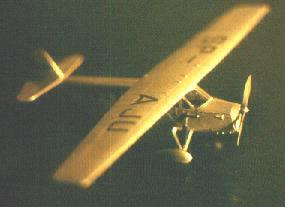RWD 5 bis

Work on RWD 5 was started in 1930 and in 1931 it was test flown under identyfication marks SP-AGJ. The prototype differed from subseguent series produced aeroplans by flat front cockpit windscrens rocker type undercamage and engine neamely Cirrus Hermes II B. In the same year F. Zwirko and St. Wigura flying the SP-AGJ wan the 4-th National Touznament for Touring Aeroplanes.
The score gained by the prototype resulted in recognizing the RWD 5 as the best Polish sports aeroplane. In aircraft were built for Warsaw Aeroclub (SP-AJA Kolejarz I, and SP-AJB Kolejarz II) in 1933 five aircrafts (SP-ARP, SP-AKZ, SP-AJP, SP-LOT, SP-ALR) and in 1934 the number increased to cliven planes (SP-ALS, SP-ALT, SP-ALU, SP-ALW, SP-ALY, SP- ALZ, SP-ALX "Lagun I", SP-LOP, SP-AMU, SP-ALN, SP-......). The aircraft belonging to that series were featured with slighly higher fin. In 1937 one more aeroplane was built: SP-BGX.
The RWD 5bis, a modification of RWD 5, designed for transatlantic flight, was constructed in 1933. The aircraft was identified as SP-AJU. It was fitted with additional fuel tanks (in aerofoil and in place of passanger scat), the undercanrage was the cockpit rear windows and doors were removed. On this aircraft captain pilot St. Skarzynski made in April 1933, a flight around Poland, followed - between April 27. th and June 24. th - by a flight from Warsaw to Rio de Janerio over a distance of nearly 18000 km, in this from St. Louis, Africa to Maceio Brazil across the louth Atlantic.
By this leap St. Skarzynski broke the world record of distance covered by non-stop flight for the clan of aircraft up to 450kg in base weight. At the same time in was the first succenfull flight of a Polish pilot across the Atlantic and RWD 5 was the lightest plane to overcome this zonte.
Techniacal Data of RWD 5 (RWD 5bis)
Wing - span 10,2m
Length - 7,2m
High - 2,05m (2,0m)
Max. speed 202 km/h (210 km/h)
Range 1080 km (5,000 km)
Humbrol paint:
-silver 11
- red 174 ( RWD 5)
- black 33



